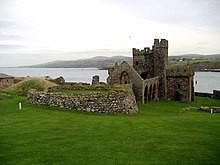Ymmydeyr:MacTire02/Aspickys Vannin
| Aspickys Vannin Diocese of Sodor and Man | |
| Queiggey | York |
|---|---|
| Aspick | Bishop of Sodor and Man |
| Moir-agglish | Moir-agglish Phurt ny h-Inshey |
| Deanaghtyn | Balley Chashtal, Doolish, Purt ny h-Inshey, Rhumsaa |
| Skeeraghyn | 28 |
| Olteynys | — |
| Ynnyd-eggey | http://www.gumbley.net/diocese.htm |
leah
[reagh | edit source]
Norway controlled all these islands until 1266, when they were ceded to Scotland. The Isle of Man was detached from the Scottish islands and came under the suzerainty of the Kings of England in 1334. Thereafter it was held by feudal Lords of Man (the Stanleys, Earls of Derby, from 1406 to 1736 and the Dukes of Atholl from 1736) until the lordship was purchased by the British Crown in 1765. The right to appoint the Bishop of Sodor and Man belonged to the Lords of Man, and continued to be exercised by the Dukes of Atholl after the revestment in 1765 until it was surrendered to the Crown in 1828. The Isle of Man was never incorporated into the Kingdom of England, or the United Kingdom, but is a Crown Dependency. In common with the rest of the Church of England, at the English Reformation the Diocese left the Roman Catholic Church under Henry VIII, the bishop Thomas Stanley was not a supporter of the reforms (particularly the reallocation of his Diocese from the Province of Canterbury to the Province of York) and was deprived of office by Henry, was briefly reunited to it under Mary I (who restored Stanley to office),[1] and separated once again under the religious settlement devised by Elizabeth I. Since the Isle of Man was not part of the Kingdom of England, the Act of Uniformity 1662 passed at the English Restoration did not apply to it, so Bishop Thomas Wilson was free to introduce worship in the Manx language during his episcopate (1697–1755), and resolve issues of clergy discipline that the Isle of Man's unique status had led to.[2]
Usage of Sodor and Man
[reagh | edit source]It is possible that the origin of the name "Sodor" was lost and its meaning was applied to St Patrick's Isle as the seat of the bishop. The termination "and Man" appears to have been added in the 17th century by a legal draughtsman ignorant of the proper application of the name of Sodor to the bishopric of Man. By the latter part of the 16th century the terms "Sodor" and "Man" had become interchangeable, the bishopric being spoken of as that of Sodor or Man. Until 1604 the bishops invariably signed themselves "Sodorensis"; between that date and 1684, sometimes they used "Soderensis" and sometimes "Sodor and Man"; and since 1684 all bishops have invariably signed "Sodor and Man".
Later history
[reagh | edit source]
The original cathedral of the Diocese of Sodor and Man was on St Patrick's Isle at Peel. This cathedral fell into disuse during the 18th century and for many years there was only a Pro-cathedral in Douglas. In 1980, the present cathedral of the Diocese of Sodor and Man, the parish church of St German in Peel, was designated by Act of Tynwald.
Since the Isle of Man is not part of the United Kingdom, the Bishop does not count as a Lord Spiritual and does not sit in the House of Lords of the United Kingdom. However, he is a member of the Legislative Council of the Isle of Man. However, in common with other Church of England Crown Appointments, the appointment of the bishop is still made on the advice of the Prime Minister of the United Kingdom, despite the fact he has no other authority on the Isle of Man.
- ↑ Phillips, Gervase (2004). "Thomas Stanley (d. 1569), in Stanley, Edward, first Baron Monteagle (c.1460–1523)," (Subscription required). Oxford Dictionary of National Biography. Oxford University Press. doi:doi:10.1093/ref:odnb/26280. Feddynit magh er 2008-10-14.
{{cite web}}: Check|doi=value (cooney); Cite has empty unknown parameter:|coauthors=(cooney) - ↑ Lua error in Module:Citation/CS1/Identifiers at line 614: attempt to index field 'known_free_doi_registrants_t' (a nil value).
